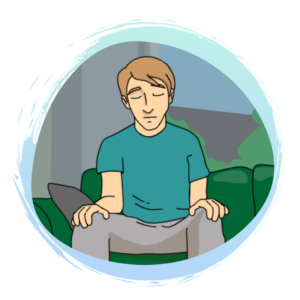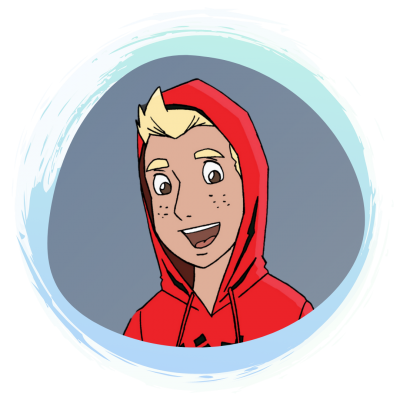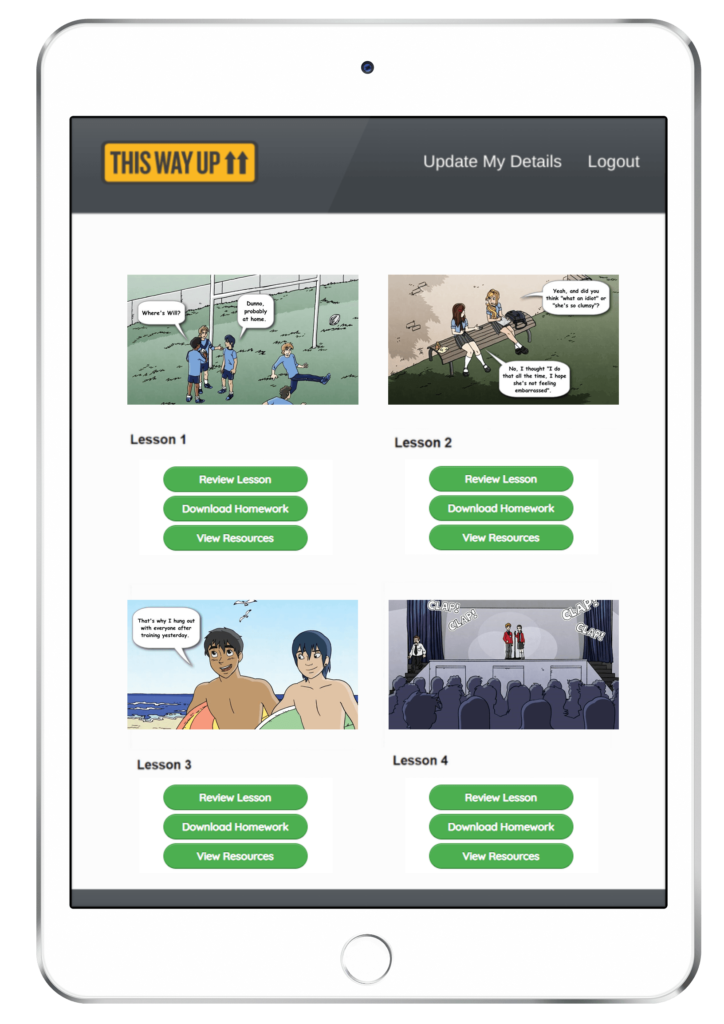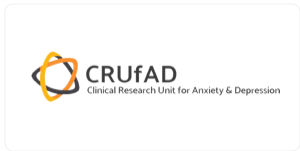Teen Worry and Sadness Program
Teens learn practical strategies for managing worry and low mood with our clinician-supported online treatment program. The teen’s parent/carer is also involved, learning tips for supporting their teen through the program.
Based on how you feel, here's what might help.

* * *
Lorem ipsum dolor sit amet, consectetur adipiscing elit. Ut elit tellus, luctus nec ullamcorper mattis, pulvinar dapibus leo.
Please select which statement best describes the way you're feeling right now.



I worry about...
At a Glance
Adolescent Mental Health & Wellbeing
Navigating the teenage years means facing many changes and challenges. It’s normal to feel sad and worried from time to time, but sometimes these feelings can stick around for longer than expected and affect our everyday life, relationships, health or self-esteem.
Worry and sadness can be early signs of anxiety and depression in adolescence, but they are treatable. Many teens who seek help can get better.
About The Teen Worry and Sadness Program
This 6-lesson treatment program is designed to teach teens (aged 12 to 17) how to manage feelings of stress, anxiety, worry or low mood and build confidence to navigate common adolescent experiences.
Teens register for the program with their parent or carer through a THIS WAY UP prescription from their clinician. Parents and carers can complete modules alongside their teen to support them as they learn new skills.
The program is based on an effective psychological treatment for signs of anxiety and depression in adolescence called Cognitive Behavioural Therapy (or CBT).

This program may be suitable for young people who:
- Are currently between 12 and 17 years old
- Have been feeling low, sad, and down, or don't seem to enjoy the things they used to enjoy
- Worry a lot about a number of different things and the worry is hard to control
- Are stuck in the way they feel and would love some help to get out of this cycle
- Are ready and willing to learn new skills to change the way they feel
What You Will Learn
Throughout this program you will follow an illustrated story of ‘Chloe’, ‘Ella’, ‘Josh’, and ‘Will’, as they learn skills for coping with sadness, stress, and adolescence. Each lesson focuses on teaching the young person a practical skill they can use to begin changing the cycle of worry and low mood. Once they complete a lesson, you will have 5 days to practice your new skill before the next lesson becomes available.
Lesson 1
Learning About Worry and Sadness – Learn how worry and sadness affect your thoughts, behaviours and physical symptoms, CBT and think about building your support network.
Lesson 2
Tackling Unhelpful Thoughts – Learn about the relationship between how you think and how you feel and practice thought challenging to help you think in more realistic and helpful ways.
Lesson 3
Boosting Mood and Facing Fears – Learn about activities you can do to feel brighter and how to confront anxiety provoking situations in a step-by-step way.

Lesson 4
Assertiveness and Coping with Stressful Situations – Learn to communicate in a confident and respectful way and learn strategies for dealing with the physical symptoms of anxiety.
Lesson 5
Solving Problems and Dealing With Worries – Learn to reduce stress using problem solving techniques and the different tools you can use when you are worried.
Lesson 6
My Toolbox of Skills and Continuing to Improve – Learn to know when to use different tools at different times and how to stay well and keep feeling better.
Access convenient, discreet, and effective online self-help...
Sometime's we're just not sure and that's ok. Let's figure it out.

* * *
Lorem ipsum dolor sit amet, consectetur adipiscing elit. Ut elit tellus, luctus nec ullamcorper mattis, pulvinar dapibus leo.
What's Included
Each of our programs has been designed to help you get the most out of self-guided learning and provides you with a range of materials to support you on your recovery journey.
Lessons
Story-based lessons that teach core coping skills
Extra Resources
Tools to help you overcome common challenges
Workbooks
Exercises designed to help you tackle your symptoms. Each lesson will be accompanied with a guide for parents/carers
Alerts & Reminders
Reminder e-mails and texts to help you stay on track
Action Plans
Step-by-step activities to help you put new skills into practice
Progress Tracking
Questionnaires to help you monitor your well-being
How to Get Started
To enrol in this program you (the young person) and your parent/carer will need to speak with your regular clinician (e.g., your GP, psychologist, or other health professional), and see if they can prescribe you this program and monitor you while you complete it.
You can download and take the Clinician Letter to your appointment or discuss wanting to sign-up to this program with your parent(s) or caregiver(s).
Speak with your usual clinician about completing this program
Get a Prescription
-
Get free access with a prescription
-
Your clinician can monitor how you are
-
Extra 12 months of access once completed
-
Available worldwide with a prescription
Please note: our programs have not been evaluated in populations who have been diagnosed as having schizophrenia or bipolar disorder; people who are dependent on drugs or alcohol; or take sedative medication (e.g., Valium, lorazepam) daily. More tailored, intensive, face-to-face support from a clinician may be more suitable for these populations and for people who are thinking about suicide. We recommend that such individuals seek clinician support and medical advice before enrolling into a self-guided online treatment program for their mental health.
Frequently Asked Questions
Over the years, we’ve helped many individuals improve their mental health through our clinical trials and online treatment programs. If you have any questions about this program, check out the FAQs below or get in touch with us.
Young people from 12-17 years old who have either:
a) been diagnosed as having anxiety and/or depression and would benefit from treatment, or
b) started to experience worry and/or sadness to the degree that is it troubling them or affecting their life and would benefit from learning strategies to feel better
This program can benefit both young people who have never done CBT before, and young people who have done or are currently doing CBT and would like a refresher of the tools.
Parents or carers of young people will also benefit from information about the CBT tools their child is learning throughout the program as well as practical suggestions for how they can support them.
Young people aged 16-17 years have the option of doing either Teen Worry and Sadness Program or the Adult Mixed Depression and Anxiety Program, if supervised by a clinician.
There are a few things to consider in determining which program might be more suitable.
Please note: these are general guidelines only and that a mental health professional who knows the adolescent can help with decision-making.
The Teen Worry and Sadness Program is targeted toward young people from age 12-17 and targets symptoms of anxiety and low mood.
The characters in the animation are adolescents and may be more relatable for younger adolescents. The Teen Worry and Sadness Program has an Information and Guide for Parents/Carers accompanying each lesson that summarises the skills the young person has learned, with practical suggestions for parents/carers on how they can help.
The rest of our program range was written for adults, and would more likely benefit older and more mature adolescents who are self-motivated and need less input from adults. Additionally, though the Teen Worry and Sadness Program covers strategies for anxiety, it teaches more general strategies for anxiety rather than a specific kind of anxiety. If a young person would benefit specifically from a Depression program, or one of our programs geared towards a particular anxiety disorder (e.g. Social Anxiety, Panic Disorder, Generalised Anxiety Disorder, Health Anxiety etc.), then this may be more suitable.
There is no right or wrong answer. We have the flexibility to allow the young person to switch to another program if they start one, but think that another one would be more appropriate.
This program is self-paced, but is designed to be completed within 3 months. It is best to do one lesson every week or two to allow time to practice between lessons.
When you complete the program in 3 months, you will be given another 12 months access to help you practice your new skills and progress further.
Please note, there is a 5-day lockout period between lessons to encourage the revision of material and to give you enough time to practice the skills you have learned.
This program is free to enrol into under the guidance of a clinician.
This program is only available for enrolment under clinician supervision. This clinician would be someone who knows you, the young person, such as your GP or another mental health professional.
We encourage young people, their parents/carers and clinician to discuss what kind of support will be most beneficial to the young person as they complete this program. Before starting the program, we recommend that you and your parent/carer discuss with your clinician how you can make contact if you have questions or concerns as you proceed though the lessons.
The parent/carer will receive an information guide with each lesson the young person does. This guide will summarise the skills taught, along with ideas for how the parent/carer can support the young person.
The young person will benefit more from this program with support from both their parent/carer and clinician. The clinician can help the young person to apply the skills covered in the program.
You (the young person) can access this program if your clinician is registered with THIS WAY UP and prescribes this program to your parent/carer by e-mailing your parent/carer a personalised registration link called a “Quickscript” using our secure online system.
Here’s how to discuss this option with your health professional:
Step 1.
Make an appointment with your clinician (e.g., your GP, Medical Specialist, Psychologist or other Allied Health Professional).
Step 2.
Download, print, and take the Clinician Letter to your appointment. This letter outlines some information about how your clinician can register with THIS WAY UP and prescribe our program using our online system.
Please note that with the Teen Worry and Sadness Program, the clinician must prescribe the program to the parent/carer’s email address. The parent/carer can begin the registration process by clicking the link included in the prescription email that they receive from THIS WAY UP. Following Step 3 of parent/carer registration, the young person’s details will be requested in order to create an account for the young person.
Step 3.
Ask your clinician if they are familiar with THIS WAY UP and tell them about the program you’d like to do.
If your clinician is new to THIS WAY UP, they may need some time to register and get to know our system, so you may not be able to get a program prescription right away.
If your clinician is able to prescribe and monitor you, the young person, throughout the program, they will send your parent/carer a ‘prescription’ e-mail called a “Quickscript” via our system with details on how to enrol.
Please note, it is up to individual clinicians to decide whether it is appropriate for them to prescribe and monitor you through one of our programs. Therefore, we cannot guarantee that your clinician will be able to assist you.
The Science Behind This Program
This program has been adapted from our adult Anxiety and Depression Program to be more suitable for young people from 12-17 years of age.
The Anxiety and Depression Program has been evaluated in randomised controlled trials and in studies in real world settings, including:
Newby et al. (2013) | Newby et al. (2014) | Newby et al. (2014) | Mahoney et al. (2021)
Why choose this way up…
Online Programs That Work
THIS WAY UP has been developing and releasing scientifically-supported online mental health programs for over a decade. We ensure that our programs help individuals achieve real positive results by conducting clinical research and adhering to the best practice guidelines in treatment of mental health conditions.
Choose to learn from a trusted Australian team that cares about your mental health
For Clinicians
This program has been developed using best practice, evidence-based strategies for the treatment of Anxiety and Depression in adolescents.
As a registered THIS WAY UP clinician you can prescribe The Teen Worry and Sadness Program to your clients and stay informed of their progress.




